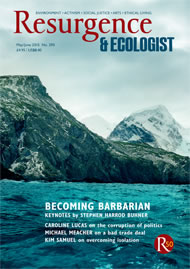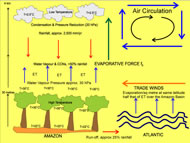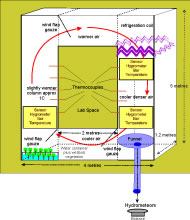Imagine being in one of the world’s wettest rainforests with three physicists puzzling over how it is possible for the rainfall to be as high thousands of kilometres inland as it is at the coast, if not higher. Indeed, Leticia, in the Colombian Amazon, on the border with Brazil and Peru, some 4º S and 3,000km inland from the equatorial coastline, gets more rain than the island of Fernando de Noronha stuck out in the equatorial Atlantic Ocean and right in the path of the Atlantic trade winds. How can that possibly be when the coast has been left far behind and rainfall, in the progression of the air mass from east to west, is constantly depleting the air of moisture? On that count, Leticia should be more a desert than a place of luxuriant biodiversity.
Well, I was lucky to have the answer from the very scientists who had conjured up an intuitively sound and logical explanation. I was with Victor Gorshkov and Anastassia Makarieva, theoretical physicists from the Institute of Nuclear Physics in St Petersburg, and Germán Poveda of the Medellín campus of the National University of Colombia, and we were scrambling our way through the Chocó rainforest, along Colombia’s Pacific coastline, one of the world’s richest areas of biodiversity.
Poveda, a member of the Intergovernmental Panel on Climate Change and full professor in the Geosciences Faculty of the Universidad Nacional, had invited the two Russians to Medellín to give a three-day course on their ‘biotic pump’ theory. In essence, Makarieva and Gorshkov claim that the condensation of water vapour at cloud-forming altitudes brings about a sharp reduction in local atmospheric pressure such as to suck up air from the surface. That upward flow leads to air moving horizontally over the surface to fill the partial vacuum. Hence their theory that the trade winds, skimming over the Atlantic on their way from Africa to equatorial South America, are sucked in as a result of cloud formation over the Amazon’s rainforests.
That process, according to the biotic pump theory, explains large-scale convection; and the theory dictates that it is not the mass circulation of air that drives the hydrological cycle – as is described in conventional climatological models – but rather the hydrological cycle that drives the mass circulation of air. If we accept the theory, the great tropical Hadley cell air mass circulation is therefore driven by the processes of convection that take place over the 6,000,000km2 Amazon basin, the ‘fuel’ for that convection being contingent on the high rate of water vapour pumping from the closed-canopy vegetation.
Were the forest to disappear, moisture would, according to the biotic pump theory, no longer be sucked in, and, given the natural fallout rate of rainfall – some 600km from evaporation to precipitation – the land would dry out and in all likelihood turn to desert. It would be a disaster of momentous proportions, not just dwarfing the likely changes resulting from global warming but indeed compounding them.
During the past 30 years of growing concern over the consequences of human-induced climate change, we have tended to ignore the hydrological role of rainforests and instead have focused on the potential release of greenhouse gases into the lower atmosphere when a forest is razed and burnt. But while deforestation has always been of considerable concern, climatologists have been adamant that the surface winds will keep blowing with the same general patterns and that rain will still fall in the deep interior of continents such as South America or Africa. Not quite ‘business-as-usual’, but the contention is that equatorial countries such as Colombia will still get a substantial part of their rains from the tropical Atlantic Ocean some 3,000km away, courtesy of the trade winds and the Walker circulation, which blows along the seasonally moving equator in what is known as the intertropical convergence zone (ITCZ).
That conclusion is predicted as a result of various theoretical studies, including those from the UK’s prestigious Hadley Centre, which state that the consequences of widespread deforestation of the Amazon basin, combined with human-induced climate change, could cause a reduction in rainfall of around 12–15% in the central and western reaches of the Amazon.
Under such circumstances the rainforest would transform to savannah, much like that naturally found in Brazil’s Mato Grosso, but not to the extent of becoming desert. For the great majority of climatologists, such an extreme consequence of deforestation is unthinkable; it does not fit their models. But those models do not include the biotic pump theory, and therefore could possibly be dangerously deficient in their analytical predictions. Not that the accepted circulation models predict a benign consequence of Amazon deforestation: even a 15% reduction in rainfall constitutes a staggering amount.
But what if the hydrologists and climatologists are wrong? What if the loss of rainforest were to have a devastating impact on the flow of surface winds such that they would no longer blow across the continental interior? What would happen to the rains then? The biotic pump theory purports to show that surface winds are sucked in from regions where the condensation of atmospheric water vapour is relatively low to those regions where it is substantially higher. The inference is that heavy cloud formation is more likely to occur over regions where water vapour generation is high, such as the tropical rainforest, which, through evapotranspiration from its leaves, pumps up more than double the quantity of water vapour per surface area than ocean at the same latitude. On that basis, the high rate of condensation at cloud level, at an altitude of from some 2.5km to 5km, brings about a sharp, well-defined pressure change as the water vapour transforms into liquid water and ice.
The very notion that the surface convection of humid air is largely the result of the pressure change resulting from condensation is not readily countenanced by hydrologists and consequently climatologists. It would mean they had left an important mechanism out of their models; moreover they insist that, even though theoretically the pressure change is a reality, it would be substantially secondary in its effect on the lower atmosphere to the release of heat – latent heat – when water vapour changes from being a gas to become liquid or even solid. Certainly the latent heat release makes the air lighter and less dense where that transformation occurs. That less dense, slightly warmer air will rise and thereby slow the temperature reduction caused by the chilling of air as it expands, and will push cloud formation and water vapour condensation higher. Hydrologists and meteorologists also take it as read that, following any perturbance including condensation and latent heat release, the lower atmosphere will settle into a state of hydrostatic equilibrium. In short, the vast majority of such scientists repudiate the biotic pump theory.
However, Gorshkov and Makarieva have stuck to their guns. They point out that the lower atmosphere cannot be in hydrostatic equilibrium when the surface atmosphere contains sufficient water vapour for condensation to occur, that being a destabilising process, given the composition and pressure change as water vapour in its ascending reaches saturation. Secondly, they show that when forests are absent, rainfall levels decline exponentially from the coast to the continental interior. That is in sharp contrast to intracontinental regions where forests cover the land, even as much as 3,000km from the ocean: there rainfall levels are as high as at the coast, if not higher. Leticia is a case in point.
In taking that idea to its logical conclusion, Makarieva and Gorshkov refer to the dire consequences of widespread deforestation inland. If Colombia’s neighbour Brazil were to deforest all the way back to the Atlantic, Leticia would receive annually some 20mm of rain, no more than Israel’s Negev desert. That contention goes hard against the grain of climate model predictions.
So, what evidence do we have that the biotic pump theory better represents actual phenomena? One telling example relates to the wettest equatorial rainforest in the world – the Chocó. The puzzle is, how can the Chocó get as much as 12m of rain a year when the prevailing winds, the Pacific trade winds, essentially move in the opposite direction, away from South America and towards Indonesia? Poveda points to an extraordinary phenomenon whereby a portion of the Pacific trade winds suddenly reverses direction and flows back over the Chocó to the Magdalena Valley in the central part of Colombia, where it clashes with the flow of air from the Amazon basin that has passed over the Eastern Andes. Colombia’s rainfall patterns in that region are determined by that encounter between the two streams of air. Poveda has few doubts that the sudden, sharp reversal of the streams of air over the Pacific Ocean is primarily a consequence of the biotic pump in action, with the rainforest pumping more water vapour into the surface atmosphere than anywhere else.
Nonetheless, the physical proof that condensation leads to surface airflow needs to be shown, and hence not just that the physics underlying the biotic pump theory is correct, but that it is the force majeure driving atmospheric processes over contiguous rainforests, such as in the Chocó, the Congo and the Amazon basin and, seasonally, over the great boreal forests of Russia and the far North. I therefore devised an experiment, which I carried out in the garden at my home in Cornwall.
The setup consists of two 5m-high plastic columns connected at the top and base to form a doughnut-like structure. The central ‘hole’ is used as a laboratory. The area throughout is 1m2. A double layer of copper condensing coils is wound around the perimeter of the right-hand column, just below the connection with the upper connecting ‘tunnel’. The condensing coils cover some 1.6m2 and are connected to an outside industrial refrigeration compressor, which has its own operating switch about 4m away from the columns.
The airflow data is obtained using a 2-D ultrasonic Gill anemometer, placed in the top connecting tunnel where it meets the right column, 25cm away from the top of the condensing coils. In addition, three Rotronic humidity sensors are deployed, one within 5cm of the top condensing coil, one 1m from the base of the right-hand column, and one 1m from the base of the left-hand column. Two barometric sensors are used, one close to the top of the condensing coils, and the other 1m from the base of the left-hand column. Thermocouples are deployed at various strategic points in both columns and in the connecting tunnels. The sensors are connected to a computer through USB ports, some of them via a Novus (Brazil) data logger.
The physics used to determine the results is standard. From the temperature, barometric pressure and relative humidity we can determine the partial pressure of water vapour in the enclosed atmosphere. Hence we can determine the partial pressure of water vapour as it changes at the point of condensation. We can then relate our findings and compare them with the measurements of airflow as determined by the anemometer.
The anemometer measurements, which include the directionality as well as the velocity of airflow, are totally independent of the measurements of temperature, relative humidity and barometric pressure, which together provide the data necessary to calculate the partial pressure of water vapour and the changes undergone. The theoretical velocity of air at any one moment can be obtained from the partial pressure and air density changes.
The results are unequivocal: the calculations of partial pressure change and of airflow velocity match extraordinarily well the actual airflow as measured with the anemometer. Moreover, the directionality once condensation gets under way is always in a clockwise direction. Critics of the conclusion that it is the rate of condensation of the water vapour that drives the airflow circulation during any one experiment follow the inherent belief that the airflow is actually driven by changes in air density. Their reasoning goes that the cooling of the air when passing over the cooling coils makes the air more dense, which it undoubtedly does, and that the cool, denser air sinks and so forces the clockwise flow that we see measured by the anemometer.
Fortunately, straightforward basic physics enables the experimenter to calculate not just the partial pressure change at the point of cooling, but also the air density change at that point in comparison to the air density further down the column. What we find is that the kinetic energy of the partial pressure change, as water vapour condenses, is at least 3,000 times greater than that for the same volume of cooler and denser air. In effect, the orthodox conclusion that it is air density change that drives the circulation, and not the air pressure change from condensation, is a total non-starter, and it shows unequivocally that the climate models are wrong in their described mechanism of air mass convection. Without exception, all the experiments, with different initial temperatures and humidity, show that the airflow results practically 100% from the condensing of water vapour and minimally from the air density change. Those results indicate that the biotic pump theory has to be correct.
Finally, we can gather the rain that falls from the condenser coils as they warm, and compare the amount with that calculated theoretically from the total change in the partial pressure of water vapour. The actual and theoretical coincide within a few grams: a nice proof that the physical theory behind the biotic pump theory accords well with reality.
The conclusion is that a simple experiment has given us the proof that the general physics underlying the biotic pump theory of Anastassia Makarieva and Victor Gorshkov is essentially correct, and that the consequences of wholescale deforestation are likely to be far more severe in terms of intracontinental rain patterns than currently predicted. The hydrological consequences of deforestation are therefore far more important than greenhouse-gas emissions resulting from the same deforestation.
Climate modellers should indeed be worried that they have got the fundamentals wrong and that it is hydrology that drives the major air mass circulation rather than the other way round. We destroy the world’s rainforests at our peril, for it is those very ecosystems that give us climate stability and enable our civilisations to flourish.
This is an edited version of a paper by Peter Bunyard that may be read at www.theecologist.org/News/news_analysis/2776099/without_its_rainforest_the_amazon_will_turn_to_desert.html









